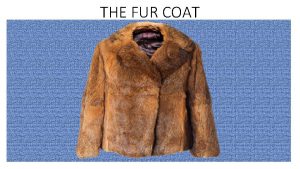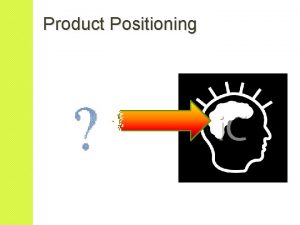5 02 Define positioning Positioning is getting consumers












- Slides: 12

5. 02

Define positioning. • Positioning is getting consumers to think of a product in a certain way.

Segmentational elements of the target market include: �Demographics. Demographic segmentation divides the market based on personal characteristics such as age, gender, income, ethnic background, education and occupation. Consumers with high income are more likely to purchase box seats. �Psychographics. Psychographic segmentation divides the market based on values, attitudes and lifestyles. Consumers who enjoy professional wrestling might not enjoy the ballet.

�Geographics. Geographic segmentation divides a market based on where a person lives. Consumers living in the Boone area are more likely to attend an event held in that area. �Behavioral segmentation divides the market into groups based on what they are looking for in a product and why they buy the product. Consumers may be loyal to Jennifer Lopez and go to as many of her concerts as possible.

�Hybrid. Consumer segments brought together using several variables. �Example: Psychodemographic segmentation might be based on education and lifestyle. �Example: Consumers with a high level of education tend to play more golf.

The consumer’s perception impacts image. �Marketers must understand the consumer’s attitudes and needs affecting perceptions. �Consumer perceptions are based on experiences. �Position products based on image. Example: Mountain Dew sponsors “extreme” sports.

◦ Niche marketing is targeting an underserved market. Characteristics of a niche market include: �Smaller markets. �Specific needs. �Example: Doritos targeting skateboarding fanatics.

• To increase market share, companies may choose to utilize a multi-positioning strategy. Multi-positioning is positioning the same product differently to a variety of markets. For example: Dell positions computers differently to mature markets than to tween markets. Mature markets are positioned through the benefits of sending/receiving email and photos from family members. Tween markets are positioned through gaming and instant messaging.

Introduction stage. • Strategies during this stage should stimulate consumer interest and create awareness. Example: A company may show more commercials to make its target market aware that the product is now available.

Growth stage. • Strategies during this stage stress benefits of a product over its competitor’s products. Example: A company may say its brand is a higher quality product than the product its competitors sell.

Maturity stage. • Strategies during this stage may include repositioning a product. Choosing a different target market to position the product. When the existing target market gets tired of a product, choosing a new group of people to market the product will make the product seem new to them.

Decline stage. • Strategies during this stage may be to greatly reduce marketing support or drop a product due to poor sales and lack of consumer interest. At some point, consumers do not want a product anymore, therefore it is time to drop the product and find something new.
 The secret to getting ahead is getting started
The secret to getting ahead is getting started Clouds
Clouds Producers primary consumers secondary consumers
Producers primary consumers secondary consumers Segmentation targeting differentiation and positioning
Segmentation targeting differentiation and positioning Consumers producers decomposers
Consumers producers decomposers Definition of position in nursing
Definition of position in nursing Market segmentation target market selection and positioning
Market segmentation target market selection and positioning Genetics yellow and blue make answer key
Genetics yellow and blue make answer key Unit 2 getting acquainted with the vehicle
Unit 2 getting acquainted with the vehicle Getting a driver license illegally may result in
Getting a driver license illegally may result in Fur coat short story summary pdf
Fur coat short story summary pdf Getting nerdy llc answer key
Getting nerdy llc answer key Is uv getting stronger
Is uv getting stronger























